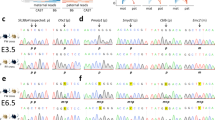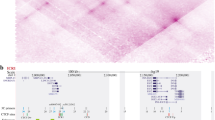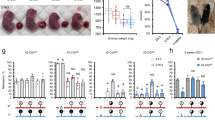Abstract
p57KIP2 is a potent tight-binding inhibitor of several G1 cyclin/Cdk complexes, and is a negative regulator of cell proliferation1,2. The gene encoding human p57KIP is located on chromosome 11 p15.5 (ref. 2), a region implicated in both sporadic cancers and Beckwith-Wiedemann syndrome, a familial cancer syndrome, marking it a tumour suppressor candidate. Several types of childhood tumours including Wilm's tumour, adrenocortical carcinoma and rhabdomyosarcoma display a specific loss of maternal 11p15 alleles, suggesting that genomic imprinting3–8 plays an important part9–12. Genetic analysis of the Beckwith-Wiedemann syndrome has indicated maternal carriers as well as suggested a role in genomic imprinting13. Here, as a first step towards elucidating the genesis of human cancers in this region, we showed that a mouse homologue of p57KIP2 is genomically imprinted. The paternally inherited allele is transcriptionally repressed and methylated. This murine gene maps to the distal region of chromosome7, within acluster of imprinted genes, including insulin-2, insulin-like growth factor-2, H19 and Mash2 (refs 14–18).
This is a preview of subscription content, access via your institution
Access options
Subscribe to this journal
Receive 12 print issues and online access
$209.00 per year
only $17.42 per issue
Buy this article
- Purchase on Springer Link
- Instant access to full article PDF
Prices may be subject to local taxes which are calculated during checkout
Similar content being viewed by others
References
Mong-Hong, L., Reynisdottir, I. & Massague, J. Cloning of p57KIP2, a cyclin-dependent kinase inhibitor with unique domain structure and tissue distribution. Genes Dev. 9, 639–649 (1995).
Matsuoka, S. et al. p57KIP2, a structurally distinct member of the p21CIP1 Cdk inhibitor family, is a candidate tumor suppressor gene. Genes Dev. 9, 650–662 (1995).
Solter, D. Differential imprinting and expression of maternal and paternal genomes. A. Rev. Genet. 22, 127–146 (1988).
Barlow, D.P. Imprinting: a gamete's point of view. Trends Genet. 10, 194–199 (1994).
Ohlsson, R., Barlow, D.P. & Surani, A. Impression of imprints. Trends Genet. 10, 415–417 (1994).
Razin, A. & Cedar, H. DNA methylation and genomic imprinting. Cell 77, 473–476 (1994).
Efstratiadis, A. Parental imprinting of autosomal mammalian genes. Curr. Opin. Genet. Dev. 4, 265–280 (1994).
Nicholls, R.D. New insights reveal complex mechanisms involved in genomic imprinting. Am. J. hum. Genet. 54, 733–740 (1994).
Schroeder, W.T. et al. Nonrandom loss of maternal chromosome 11 alleles in Wilms tumors. Am. J. hum. Genet. 40, 413–420 (1987).
Pal, N. et al. Preferential loss of maternal alleles in sporadic Wilms' tumour. Oncogene. 5, 1665–1668 (1990).
Scrable, H. et al. A model for embryonal rhabdomyosarcoma tumorigenesis that involves genome imprinting. Proc. natn. Acad. Sci. U.S.A. 86, 7480–7484 (1989).
Seizinger, B. et al. Report of the committee on chromosome and gene loss in human neoplasia. Cytogenet. cell. Genet. 58, 1080–1096 (1991).
Lubinsky, M., Herrmann, J., Kosseff, A.L. & Opitz, J.M. Autosomal-dominant sex-dependent transmission of the Wiedemann-Beckwith syndrome. Lancet 1, 932 (1974).
Bartolomei, M.S., Zemel, S. & Tilghman, S.M. Parental imprinting of the mouse H19 gene. Nature 351, 153–155 (1991).
Dechiara, T.M., Robertson, E.J. & Efstratiadis, A. Parental imprinting of the mouse insulin-like growth factor II gene. Cell 64, 849–859 (1991).
Zemel, S., Bartolomei, M.S. & Tilghman, S.M. Physical linkage of two mammalian imprinted genes, H19 and insulin-like growth factor 2. Nature Genet. 2, 259–264 (1992).
Giddings, S.J., King, C.D., Harman, K.W., Flood, J.F. & Carnaghi, L.R. Allele specific inactivation of insulin 1 and 2, in the mouse yolk sac, indicates imprinting. Nature Genet. 6, 310–313 (1994).
Guillemot, F. et al. Genomic imprinting of Mash2, mouse gene required for trohpoblast development. Nature Genet. 9, 235–242 (1995).
Veres, G., Gibbs, R.A., Scherer, S.E. & Caskey, C.T. The molecular basis of the sparse fur mouse mutation. Science 237, 415–417 (1987).
Kafri, T. et al. Developmental pattern of gene-specific DNA methylation in the mouse embryo and germ line. Genes Dev. 6, 705–714 (1992).
Hatada, I. et al. Allele-specific methylation and expression of an imprinted U2af1-rs1 (SP2) gene. Nucl. Acids Res. 23, 36–41 (1995).
Neumann, B., Kubicka, P. & Barlow, D.P. Characteristics of imprinted genes. Nature Genet. 9, 12–13 (1995).
Searle, A.G. & Beechey, C.V. Genomic imprinting phenomena on mouse chromosome 7. Genet. Res. 56, 237–244 (1990).
Mclaughlin, K.J., Szabo, P. & Mann, J.R. Mouse embryos with paternal duplication of distal chromosome 7 are lethal at midgestation and possess aberrant expression levels of Igf2 and H19. Genes Dev. (in the press).
Seizinger, B. et al. Report of the committee on chromosome and gene loss in human neoplasia. Cytogenet. Cell. Genet. 58, 1080–1096 (1991).
Kamb, A. et al. A cell cycle regulator potentially involved in genesis of many tumor types. Science 264, 436–440 (1994).
Chomczynski, P. & Sacchi, N. Single-step method of RNA isolation by acid guanidine thiocyanate-phenol-chloroform extraction. Anal. Biochem. 162, 156–159 (1987).
Brandeis, M. et al. The ontogeny of allele-specific methylation associated with imprinted genes in the mouse. EMBO J. 12, 3669–3677 (1993).
Dietrich, W. et al. A genetic map of the mouse with 4006 simple sequence length polymorphisms. Nature Genet. 7, 220–245 (1994).
Author information
Authors and Affiliations
Rights and permissions
About this article
Cite this article
Hatada, I., Mukai, T. Genomic imprinting of p57KIP2, a cyclin–dependent kinase inhibitor, in mouse. Nat Genet 11, 204–206 (1995). https://doi.org/10.1038/ng1095-204
Received:
Accepted:
Issue Date:
DOI: https://doi.org/10.1038/ng1095-204
This article is cited by
-
Cell cycle regulators and bone: development and regeneration
Cell & Bioscience (2023)
-
Relevance of next generation sequencing (NGS) data re-analysis in the diagnosis of monogenic diseases leading to organ failure
BMC Medical Genomics (2023)
-
Advances in translational research of the rare cancer type adrenocortical carcinoma
Nature Reviews Cancer (2023)
-
Drug-induced loss of imprinting revealed using bioluminescent reporters of Cdkn1c
Scientific Reports (2023)
-
Imprinted Cdkn1c genomic locus cell-autonomously promotes cell survival in cerebral cortex development
Nature Communications (2020)



